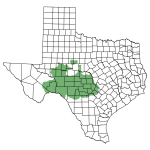
The Edwards Plateau Ecoregion
Conservation of this region is paramount – it is estimated that up to 90% has been converted to pasture, urban areas, and agricultural crops. The limestone bedrock of the Edwards Plateau helps to contribute to the distinctiveness of the biota. An array of species are specialists on limestone habitats, including caves. Some of the largest assemblages of cave-dwelling bats anywhere in the world, indeed the largest aggregations of mammals anywhere in the world, roost in several of the large caves of this ecoregion. Millions of Mexican free-tailed bats (Tadarida brasiliensis) use these caves as maternity roosts, creating a globally outstanding phenomena. The high number of endemic invertebrate cave species also qualify this ecoregion as a global hotspot for cave-dwelling species. The aquatic vertebrates endemic to the Plateau include the widemouth blindcat (Satan eurystomus), San Marcos salamander (Eurycea nana), Comal blind salamander (Eurycea tridentifera), Texas blind salamander (Typhlomolge rathbuni), Blanco blind salamander (Typhlomolge robusta), and the Texas salamander (Eurycea neotenes).

Comal blind salamander. Image courtesy of Joe Furman.
This ecoregion also ranks among the top ten ecoregions for reptiles and birds. The Edwards Plateau Savannas contains most of the breeding habitat for an endemic migratory warbler, the golden-cheeked warbler (Dendroica chrysoparia), which nests only in mature oak-juniper savannas, or cedar brakes. Some important breeding habitat for the black-capped vireo (Vireo atricapillus), a species endangered by habitat loss, occurs in this ecoregion. A disjunct population of maples (Acer spp.) occur in mesic pockets, an unusual example of a relict population in a presently dry region.

The Edwards Aquifer. Map courtesy of edwardsaquifer.net.
Only about two percent of the remaining habitat in this important ecoregion is considered intact. Important ecological processes such as fire have been suppressed, leading to changes in vegetation structure and composition. Extensive soil loss has contributed to changes in the disturbance regimes of riparian communities. Overgrazing has fragmented and eliminated native grasslands and contributed to the expansion of woody species. In addition, groundwater depletion has impacted several of the region’s important aquifers. The southern and western portions of the Edwards Plateau are heavily altered by major encroachment of shrubs as a result of fire suppression. The eastern section of the plateau is in better condition and contains much second growth.